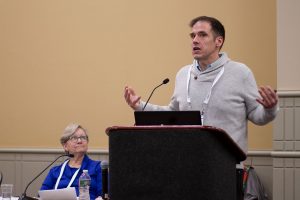Even the most welcoming of makerspaces can be intimidating. While much of the focus on makerspaces highlights their function as a center for STEM learning, introducing a more holistic approach can help students feel more comfortable while enhancing social-emotional skills. In “The Library, Not Just for Books: Connecting Library, Maker, and Social Emotional Learning,” Velear Schrupp, library director at TVT Community Day School in Irvine, California, shared her approach to combining social-emotional learning with information literacy and maker practices in her school library on Saturday at the ALA Midwinter Meeting & Exhibits in Philadelphia.
To explore the roles a library can play in hosting a makerspace, Schrupp posed three questions:
- Why host a makerspace? Knowing how it fits into a school’s mission and objective will guide how you choose resources and what types of activities will take place.
- What is the focus? “There are a lot of approaches out there,” Schrupp said, and “there’s not necessarily a right or wrong.” Social-emotional learning is the focus of her approach.
- How will you fulfill your focus? For Schrupp, that means building relationships and connections through stories.

Photo: Rebecca Lomax/American Libraries
As an example of how social-emotionally informed design activities can work, Schrupp led session participants in a “Lego interview.” One person asked questions and, based on what they’d learned about their partner, built a small Lego sculpture that they thought the person they’d interviewed would like. Then, the interviewer had to explain to the recipient why they thought they’d like it. She followed the activity, as she always does with her students, with a reflection on what worked and what didn’t, and what was challenging and fun.
“When students can recognize their feelings, they can interact more deeply with maker activities,” Schrupp said. She uses stories to encourage students to identify a character, think about how that character feels, identify what their need or problem might be, and find a solution to the problem or need. By engaging students in this kind of emotional reflection, they are better able to name and express their own feelings. Sometimes, after these brainstorming sessions, students will then build the solutions they came up with over several more library sessions.
To demonstrate this process, Schrupp led session attendees in a brainstorming session using Humpty Dumpty. Participants wrote or drew how they thought Humpty Dumpty might feel, what he might need, and how they could help. As Schrupp led the reflection afterward, one attendee observed that this was the first time she’d thought about how Humpty Dumpty felt—that he might have been scared or didn’t understand what had happened to him.
When it comes to design challenges, Schrupp looks everywhere for inspiration—different industries, the news, the internet. “I try to bring that energy and curiosity and share it back with my students,” she said. But it’s not a one-way street. “Student voice is supposed to be part of the design process. Allow them an opportunity to create the narrative as well,” she added.
Getting past negative thoughts students might have about their ability to problem-solve can take time. Sometimes students’ stereotypes of their own skills—“This isn’t what I do: I’m not an engineer, I’m not an artist”—can be hard to overcome. Schrupp suggested some short warmups before “hefty thinking,” like writing down as many uses as you can think of for common objects or mindful exercises like listening for the end of a bell’s tone. “When we’re working on brainstorming … sometimes taking these moments can help students get into the right mindset,” Schrupp said. “Thinking breaks”—giving students time for guided, structured movement between intense brainstorming—are just as important.
“I am working to get students to be empowered,” Schrupp said, “and to be independent, thoughtful people in the world.”

